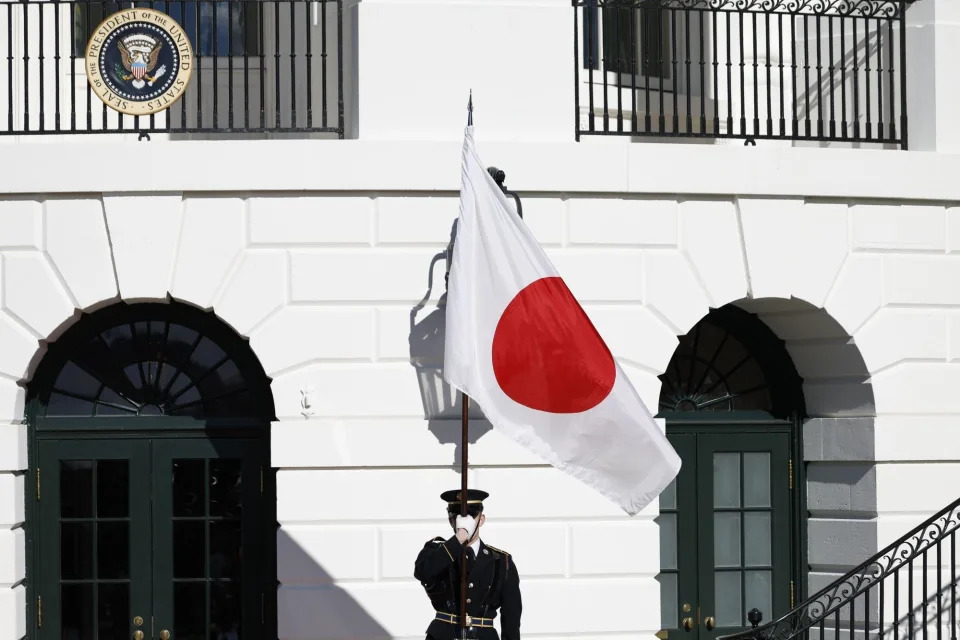
Steve Mollman
Thu, January 26, 2023
Bill Gates sees China’s rise as a "huge win for the world.” But he knows that not everyone shares his view.
Speaking this week at the Lowy Institute, a think tank based in Sydney, the Microsoft cofounder gave his perspective on China’s transformation from a developing economy to a major world player.
“China has gone from in 1980 being incredibly impoverished—poorer than India, I mean literally, with starvation, malnutrition—to being the most wealthy middle-income country in the world,” said Gates. “It’s incredible, and it’s great for the world.”
The Microsoft billionaire, who currently ranks as the fourth richest person in the world, also warned about the negative attitudes toward China in the United States today, and vice versa.
“I do think the current mentality of the U.S. to China, and which is reciprocated, is kind of a lose-lose mentality,” he said. “If you ask U.S. politicians, ‘Hey, would you like the Chinese economy to shrink by 20% or grow by 20%,' I'm afraid they would vote that, ‘Yeah, let’s immiserate those people’—not understanding that for the global economy, the invention of cancer drugs, the solution of climate change, you know, we're all in this together."
The current hawkishness toward China in the U.S. could become “self-fulfilling in a very negative way,” he cautioned. He didn’t give an example. U.S. lawmakers voted overwhelmingly this month to establish a House select committee specifically to address the various threats that China poses to the U.S. GOP Wisconsin Rep. Mike Gallagher described a “coordinated whole-of-society strategy to undermine American leadership and American sovereignty” by the Chinese Communist Party.
Gates also noted China’s economic importance, saying it holds 20% of the world’s people.
“Their portion of the global economy and their portion of the global population match exactly. Countries like Australia, U.S., we have per capita GDPs five times what the Chinese have, so we have a disproportionate share of the world's economy."
But it wasn’t all rosy. Gates also leveled criticism at China. The country is "not a democracy," he acknowledged, and is an "outlier today in terms of that level of wealth and still being as autocratic as they are."
He also knocked China for not acting quickly enough to get its population properly vaccinated early during the COVID pandemic.
China “should have jumped on vaccines, particularly for the elderly, much faster, and that would have allowed them to open up somewhat sooner than they did,” he said.
China recently loosened its strict COVID restrictions and is reporting an uptick in COVID deaths as people circulate more freely, but the official numbers are likely far below reality. “We’ll never know the true death numbers,” Gates said.
Still, Gates said nations like China needed to step up on the world stage.
“The U.S. is politically weaker today, I would say, than it's been, and, you know, that's scary for the world,” he said. “The current world system is designed around U.S. leadership. As other countries have gotten richer, these middle-income countries including China and India need to play a stronger role in world governance."
This story was originally featured on Fortune.com
Isabel Reynolds
Thu, January 26, 2023

(Bloomberg) -- China is “100% sure” to retaliate over Japanese backing for Biden administration restrictions on semiconductor exports, and firms facing the fallout should look for markets elsewhere, a ruling Liberal Democratic Party lawmaker said.
“China will come back with stronger retaliation and Japanese companies doing business there will probably be damaged,” said Shigeharu Aoyama, who serves on the party’s committee covering trade and industry. He made the comments in a Thursday interview with Bloomberg News after it reported the Netherlands and Japan are close to joining the US-led effort to restrict exports of the technology to China.
Japan and the Netherlands are home to key suppliers of semiconductor manufacturing equipment, but it is not yet clear what form their restrictions would take.
“They should take that as a turning point and look for other markets,” he added, saying he backed Japan’s participation in the measures.
US Poised for Dutch, Japanese Help on China Chip Crackdown
China is Japan’s largest trading partner and has said the US effort showed its “selfish hegemonic interest.” The Biden administration issued sweeping new rules in October that include restrictions on the supply of US manufacturers’ most advanced chipmaking equipment to Chinese customers and limits on Americans working for Chinese semiconductor firms, a move aimed at choking off access to certain expertise.
Dutch chip equipment giant ASML told Bloomberg the US-led measures could also push Beijing to develop its own technology in advanced semiconductor-making machinery.
Beijing last month filed a complaint with the World Trade Organization aimed at overturning the US-imposed export controls. It also has a history of deploying economic sanctions amid political disputes with its neighbors.
China Hits Back at South Korea, Japan in Covid Retaliation
Earlier this month, Beijing stopped issuing visas for travelers from Japan and short-term visitors from South Korea in retaliation for the two countries introducing Covid-19 testing and other restrictions on people traveling from mainland China.
In 2017, China also dramatically scaled back trade with South Korea after then-President Moon Jae-in agreed to host a US anti-missile system. And in 2010, China banned exports of rare earths to Japan as tensions rose over East China Sea islands claimed by both countries.
--With assistance from Yuki Hagiwara.
What the West Gets Wrong About China
Three fundamental misconceptions
by Rana Mitter and
Elsbeth Johnson
From the Magazine (May–June 2021)

Yukai Du
When we first traveled to China, in the early 1990s, it was very different from what we see today. Even in Beijing many people wore Mao suits and cycled everywhere; only senior Chinese Communist Party (CCP) officials used cars. In the countryside life retained many of its traditional elements. But over the next 30 years, thanks to policies aimed at developing the economy and increasing capital investment, China emerged as a global power, with the second-largest economy in the world and a burgeoning middle class eager to spend.
One thing hasn’t changed, though: Many Western politicians and business executives still don’t get China. Believing, for example, that political freedom would follow the new economic freedoms, they wrongly assumed that China’s internet would be similar to the freewheeling and often politically disruptive version developed in the West. And believing that China’s economic growth would have to be built on the same foundations as those in the West, many failed to envisage the Chinese state’s continuing role as investor, regulator, and intellectual property owner.
Why do leaders in the West persist in getting China so wrong? In our work we have come to see that people in both business and politics often cling to three widely shared but essentially false assumptions about modern China. As we’ll argue in the following pages, these assumptions reflect gaps in their knowledge about China’s history, culture, and language that encourage them to draw persuasive but deeply flawed analogies between China and other countries.
[ Myth 1 ]
Economics and Democracy Are Two Sides of the Same Coin
Many Westerners assume that China is on the same development trajectory that Japan, Britain, Germany, and France embarked on in the immediate aftermath of World War II—the only difference being that the Chinese started much later than other Asian economies, such as South Korea and Malaysia, after a 40-year Maoist detour. According to this view, economic growth and increasing prosperity will cause China to move toward a more liberal model for both its economy and its politics, as did those countries.
It’s a plausible narrative. As the author Yuval Noah Harari has pointed out, liberalism has had few competitors since the end of the Cold War, when both fascism and communism appeared defeated. And the narrative has had some powerful supporters. In a speech in 2000 former U.S. President Bill Clinton declared, “By joining the WTO, China is not simply agreeing to import more of our products, it is agreeing to import one of democracy’s most cherished values: economic freedom. When individuals have the power…to realize their dreams, they will demand a greater say.”
But this argument overlooks some fundamental differences between China and the United States, Japan, Britain, Germany, and France. Those countries have since 1945 been pluralist democracies with independent judiciaries. As a result, economic growth came in tandem with social progress (through, for example, legislation protecting individual choice and minority rights), which made it easy to imagine that they were two sides of a coin. The collapse of the USSR appeared to validate that belief, given that the Soviet regime’s inability to deliver meaningful economic growth for its citizens contributed to its collapse: Russia’s eventual integration into the global economy (perestroika) followed Mikhail Gorbachev’s political reforms (glasnost).
Many Chinese believe that the country’s recent economic achievements have actually come about because of, not despite, China’s authoritarian form of government.
In China, however, growth has come in the context of stable communist rule, suggesting that democracy and growth are not inevitably mutually dependent. In fact, many Chinese believe that the country’s recent economic achievements—large-scale poverty reduction, huge infrastructure investment, and development as a world-class tech innovator—have come about because of, not despite, China’s authoritarian form of government. Its aggressive handling of Covid-19—in sharp contrast to that of many Western countries with higher death rates and later, less-stringent lockdowns—has, if anything, reinforced that view.
China has also defied predictions that its authoritarianism would inhibit its capacity to innovate. It is a global leader in AI, biotech, and space exploration. Some of its technological successes have been driven by market forces: People wanted to buy goods or communicate more easily, and the likes of Alibaba and Tencent have helped them do just that. But much of the technological progress has come from a highly innovative and well-funded military that has invested heavily in China’s burgeoning new industries. This, of course, mirrors the role of U.S. defense and intelligence spending in the development of Silicon Valley. But in China the consumer applications have come faster, making more obvious the link between government investment and products and services that benefit individuals. That’s why ordinary Chinese people see Chinese companies such as Alibaba, Huawei, and TikTok as sources of national pride—international vanguards of Chinese success—rather than simply sources of jobs or GDP, as they might be viewed in the West.
Thus July 2020 polling data from the Ash Center at Harvard’s Kennedy School of Government revealed 95% satisfaction with the Beijing government among Chinese citizens. Our own experiences on the ground in China confirm this. Most ordinary people we meet don’t feel that the authoritarian state is solely oppressive, although it can be that; for them it also provides opportunity. A cleaner in Chongqing now owns several apartments because the CCP reformed property laws. A Shanghai journalist is paid by her state-controlled magazine to fly around the world for stories on global lifestyle trends. A young student in Nanjing can study propulsion physics at Beijing’s Tsinghua University thanks to social mobility and the party’s significant investment in scientific research.
Many Chinese believe that the country’s recent economic achievements have actually come about because of, not despite, China’s authoritarian form of government.
The past decade has, if anything, strengthened Chinese leaders’ view that economic reform is possible without liberalizing politics. A major turning point was the financial crisis of 2008, which in Chinese eyes revealed the hollowness of the “Washington consensus” that democratization and economic success were linked. In the years since, China has become an economic titan, a global leader in technology innovation, and a military superpower, all while tightening its authoritarian system of government—and reinforcing a belief that the liberal narrative does not apply to China. That, perhaps, is why its current president and (more crucially) party general secretary, Xi Jinping, has let it be known that he considers Gorbachev a traitor to the cause for liberalizing as he did, thereby destroying the Communist Party’s hold on the USSR. And when Xi announced, in 2017, that the “three critical battles” for China’s development would fall in the areas of reducing financial risk, addressing pollution, and alleviating poverty, he also made it clear that the objective of these reforms was to solidify the system rather than to change it. The truth, then, is that China is not an authoritarian state seeking to become more liberal but an authoritarian state seeking to become more successful—politically as well as economically.
In much Western analysis the verb most commonly attached to China’s reforms is “stalled.” The truth is that political reform in China hasn’t stalled. It continues apace. It’s just not liberal reform. One example is the reinvention in the late 2010s of the Central Commission for Discipline Inspection. Empowered by Xi to deal with the corruption that had become so prevalent early in that decade, the commission can arrest and hold suspects for several months; its decisions cannot be overturned by any other entity in China, not even the supreme court. The commission has succeeded in reducing corruption in large part because it is essentially above the law—something unimaginable in a liberal democracy. These are the reforms China is making—and they need to be understood on their own terms, not simply as a distorted or deficient version of a liberal model.
One reason that many people misread China’s trajectory may be that—particularly in the English-language promotional materials the Chinese use overseas—the country tends to portray itself as a variation on a liberal state, and therefore more trustworthy. It often compares itself to brands with which Westerners are familiar. For example, in making the case for why it should be involved in the UK’s 5G infrastructure rollout, Huawei styled itself the “John Lewis of China,” in reference to the well-known British department store that is regularly ranked as one of the UK’s most trusted brands. China is also often at pains to suggest to foreign governments or investors that it is similar to the West in many aspects—consumer lifestyles, leisure travel, and a high demand for tertiary education. These similarities are real, but they are manifestations of the wealth and personal aspirations of China’s newly affluent middle class, and they in no way negate the very real differences between the political systems of China and the West.
Which brings us to the next myth.
[ Myth 2 ]
Authoritarian Political Systems Can’t Be Legitimate
Many Chinese not only don’t believe that democracy is necessary for economic success but do believe that their form of government is legitimate and effective. Westerners’ failure to appreciate this explains why many still expect China to reduce its role as investor, regulator, and, especially, intellectual property owner when that role is in fact seen as essential by the Chinese government.
Part of the system’s legitimacy in the eyes of the Chinese is, again, rooted in history: China has often had to fight off invaders and, as is rarely acknowledged in the West, fought essentially alone against Japan from 1937 until 1941, when the U.S. entered World War II. The resulting victory, which for decades the CCP spun as its solo vanquishing of an external enemy, was reinforced by defeat of an internal one (Chiang Kai-shek in 1949), establishing the legitimacy of the party and its authoritarian system.
Seventy years on, many Chinese believe that their political system is now actually more legitimate and effective than the West’s. This is a belief alien to many Western business executives, especially if they’ve had experience with other authoritarian regimes. The critical distinction is that the Chinese system is not only Marxist, it’s Marxist-Leninist. In our experience, many Westerners don’t understand what that means or why it matters. A Marxist system is concerned primarily with economic outcomes. That has political implications, of course—for example, that the public ownership of assets is necessary to ensure an equal distribution of wealth—but the economic outcomes are the focus. Leninism, however, is essentially a political doctrine; its primary aim is control. So a Marxist-Leninist system is concerned not only with economic outcomes but also with gaining and maintaining control over the system itself.
That has huge implications for people seeking to do business in China. If China were concerned only with economic outcomes, it would welcome foreign businesses and investors and, provided they helped deliver economic growth, would treat them as equal partners, agnostic as to who owned the IP or the majority stake in a joint venture. But because this is also a Leninist system, those issues are of critical importance to Chinese leaders, who won’t change their minds about them, however effective or helpful their foreign partners are economically.
This plays out every time a Western company negotiates access to the Chinese market. We have both sat in meetings where business executives, particularly in the technology and pharmaceutical sectors, expressed surprise at China’s insistence that they transfer ownership of their IP to a Chinese company. Some have expressed optimism that China’s need for control will lessen after they’ve proved their worth as partners. Our response? That’s not likely, precisely because in China’s particular brand of authoritarianism, control is key.

A Leninist approach to selecting future leaders is also a way the CCP has maintained its legitimacy, because to many ordinary Chinese, this approach produces relatively competent leaders: They are chosen by the CCP and progress through the system by successfully running first a town and then a province; only after that do they serve on the Politburo. You can’t become a senior leader in China without having proved your worth as a manager. China’s leaders argue that its essentially Leninist rule book makes Chinese politics far less arbitrary or nepotistic than those of many other, notably Western, countries (even though the system has its share of back-scratching and opaque decision-making).
Familiarity with Leninist doctrine is still important for getting ahead. Entry to the CCP and to a university involves compulsory courses in Marxist-Leninist thought, which has also become part of popular culture, as evidenced by the 2018 TV talk show Marx Got It Right. And with handy apps such as Xuexi Qiangguo (“Study the powerful nation” and a pun on “Study Xi”) to teach the basics of thinkers including Marx, Lenin, Mao, and Xi Jinping, political education is now a 21st-century business.
The Leninist nature of politics is also evidenced by the language used to discuss it. Political discourse in China remains anchored in Marxist-Leninist ideas of “struggle” (douzheng) and “contradiction” (maodun)—both seen as attributes that force a necessary and even healthy confrontation that can help achieve a victorious outcome. In fact, the Chinese word for the resolution of a conflict (jiejue) can imply a result in which one side overcomes the other, rather than one in which both sides are content. Hence the old joke that China’s definition of a win-win scenario is one in which China wins twice.
China uses its particular authoritarian model—and its presumed legitimacy—to build trust with its population in ways that would be considered highly intrusive in a liberal democracy. The city of Rongcheng, for example, uses big data (available to the government through surveillance and other data-capturing infrastructure) to give people individualized “social credit scores.” These are used to reward or punish citizens according to their political and financial virtues or vices. The benefits are both financial (for example, access to mortgage loans) and social (permission to buy a ticket on one of the new high-speed trains). Those with low social-credit scores may find themselves prevented from buying an airline ticket or getting a date on an app. For liberals (in China and elsewhere), this is an appalling prospect; but for many ordinary people in China, it’s a perfectly reasonable part of the social contract between the individual and the state.
Such ideas may appear very different from the outward-facing, Confucian concepts of “benevolence” and “harmony” that China presents to its international, English-speaking audience. But even those concepts lead to considerable misunderstanding on the part of Westerners, who often reduce Confucianism to cloying ideas about peace and cooperation. For the Chinese, the key to those outcomes is respect for an appropriate hierarchy, itself a means of control. While hierarchy and equality may appear to the post-Enlightenment West to be antithetical concepts, in China they remain inherently complementary.
Recognizing that the authoritarian Marxist-Leninist system is accepted in China as not only legitimate but also effective is crucially important if Westerners are to make more-realistic long-term decisions about how to deal with or invest in the country. But the third assumption can also mislead those seeking to engage with China.
[ Myth 3 ]
The Chinese Live, Work, and Invest Like Westerners
China’s recent history means that Chinese people and the state approach decisions very differently from Westerners—in both the time frames they use and the risks they worry about most. But because human beings tend to believe that other humans make decisions as they do, this may be the most difficult assumption for Westerners to overcome.
Let’s imagine the personal history of a Chinese woman who is 65 today. Born in 1955, she experienced as a child the terrible Great Leap Forward famine in which 20 million Chinese starved to death. She was a Red Guard as a teenager, screaming adoration for Chairman Mao while her parents were being re-educated for being educated. By the 1980s she was in the first generation to go back to university, and even took part in the Tiananmen Square demonstration.
Then, in the 1990s, she took advantage of the new economic freedoms, becoming a 30-something entrepreneur in one of the new Special Economic Zones. She bought a flat—the first time anyone in her family’s history had owned property. Eager for experience, she took a job as an investment analyst with a Shanghai-based foreign asset manager, but despite a long-term career plan mapped out by her employer, she left that company for a small short-term pay raise from a competitor. By 2008 she was making the most of the rise in disposable incomes by buying new consumer goods that her parents could only have dreamt about. In the early 2010s she started moderating her previously outspoken political comments on Weibo as censorship tightened up. By 2020 she was intent on seeing her seven-year-old grandson and infant granddaughter (a second child had only recently become legal) do well.
Had she been born in 1955 in almost any other major economy in the world, her life would have been much, much more predictable. But looking back over her life story, one can see why even many young Chinese today may feel a reduced sense of predictability or trust in what the future holds—or in what their government might do next.
When life is (or has been within living memory) unpredictable, people tend to apply a higher discount rate to potential long-term outcomes than to short-term ones—and a rate materially higher than the one applied by people living in more-stable societies. That means not that these people are unconcerned with long-term outcomes but, rather, that their risk aversion increases significantly as the time frame lengthens. This shapes the way they make long-term commitments, especially those that entail short-term trade-offs or losses.
That focus on securing short-term gain is why the young asset manager in Shanghai left a good long-term job for a relatively small but immediate pay raise—behavior that still plagues many businesses trying to retain talent and manage succession pipelines in China. People who do take long-term career risks often do so only after fulfilling their primary need for short-term security. For example, we’ve interviewed couples in which the wife “jumps into the sea” of starting her own business—becoming one of China’s many female entrepreneurs—because her husband’s stable but lower-paid state-sector job will provide the family with security. The one long-term asset class in which increasing numbers of Chinese are invested—that is, residential property, ownership of which grew from 14% of 25-to-69-year-olds in 1988 to 93% by 2008—is driven also by the need for security: Unlike all other assets, property ensures a roof over one’s head if things go wrong, in a system with limited social welfare and a history of sudden policy changes.
China’s rulers see foreign engagement as a source less of opportunity than of threat, uncertainty, and even humiliation.
In contrast, the government’s discount rate on the future is lower—in part because of its Leninist emphasis on control—and explicitly focused on long-term returns. The vehicles for much of this investment are still the CCP’s Soviet-style five-year plans, which include the development of what Xi has termed an “eco-civilization” built around solar energy technology, “smart cities,” and high-density, energy-efficient housing. Ambition like that can’t be realized without state intervention—relatively fast and easy but often brutal in China. By comparison, progress on these issues is for Western economies extremely slow.
Decisions—by both individuals and the state—about how to invest all serve one purpose: to provide security and stability in an unpredictable world. Although many in the West may believe that China sees only opportunity in its 21st-century global plans, its motivation is very different. For much of its turbulent modern history, China has been under threat from foreign powers, both within Asia (notably Japan) and outside it (the UK and France in the mid 19th century). China’s rulers, therefore, see foreign engagement as a source less of opportunity than of threat, uncertainty, and even humiliation. They still blame foreign interference for many of their misfortunes, even if it occurred more than a century ago. For example, the British role in the Opium Wars of the 1840s kicked off a 100-year period that the Chinese still refer to as the Century of Humiliation. China’s history continues to color its view of international relations—and in large part explains its current obsession with the inviolability of its sovereignty.
That history also explains the paradox that the rulers and the ruled in China operate on very different time frames. For individuals, who’ve lived through harsh times they could not control, the reaction is to make some key choices in a much more short-term way than Westerners do. Policy makers, in contrast, looking for ways to gain more control and sovereignty over the future, now play a much longer game than the West does. This shared quest for predictability explains the continuing attractiveness of an authoritarian system in which control is the central tenet.
A version of this article appeared in the May–June 2021 issue of Harvard Business Review.
Elsbeth Johnson, formerly the strategy director for Prudential PLC’s Asian business, is a senior lecturer at MIT’s Sloan School of Management and the founder of SystemShift, a consulting firm.










